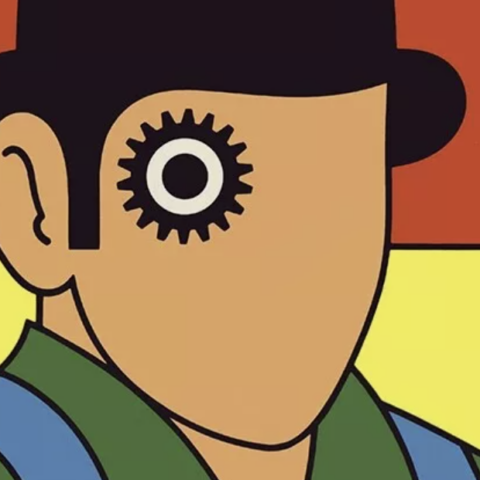What draws you to a movie when you first see it?
By Nhi Phan
Is it the bold colours that catch your eye, the intriguing design that sparks curiosity, or the promise of an unforgettable story? Film posters have this magical way of pulling us in, long before the opening credits even roll. In the world of movies, posters are snapshots of culture, pieces of art that capture the spirit of their time. If you’re curious to see how these designs shaped our love for movies, you will want to dive into What draws you to a movie when you first see it.
The image on the left The Silence of Lambs, 1991 Reel Art Press
Movie posters have been around for over a century, and they’ve been grabbing our attention ever since. The very first one appeared way back in 1896, advertising the Lumière brothers’ screening in Paris. That poster set the stage for what would become a whole new art form: capturing the spirit of a film in a single image, and doing it in a way that speaks to us all, no matter where we are in the world.
There’s something immediate about movie posters, isn’t there? They hit you with emotion, whether they’re teasing, shocking, or seducing you to step inside the theatre. The artists behind many of them were pioneers, like Saul Bass, Paul Rand, and Bill Gold, pushing the boundaries of design.
And then there’s the incredible work from Eastern European artists, with their surreal, almost dreamlike visions, often daring to be different in ways that were truly groundbreaking. Even today, movie posters continue to evolve, with modern designers taking on the challenge of branding in a whole new way.
But here’s the thing about movie posters: they don’t just promote films. They connect us. Whether it’s a classic from the 1940s or the latest blockbuster, these posters unite audiences across generations and cultures. They reflect their time and place, sure, but they also tap into something universal. They are like little windows into the world of cinema that bring us all together through our shared love of movies.
And now, 1001 Movie Posters: Designs of the Times, published in September 2024 by Reel Art Press, pulls all of this together in the most comprehensive collection of movie posters ever. Edited by the brilliant Tony Nourmand, this 640-page book spans more than a century of global film imagery, from those first colourful Parisian lithographs promoting the Lumière brothers’ films, all the way to the stunning posters for recent hits like Parasite and Barbie.
This book isn’t just for film buffs, it’s for anyone who loves design, creativity, and the magic of visual storytelling. You’ll find posters for iconic films like Metropolis, where Boris Bilinsky’s futuristic vision captured the towering steel structures of a dystopian future.
Metropolis, 1927 Reel Art Press
King Kong, with its dramatic, larger-than-life imagery brought the towering beast to life on screen.
King Kong, 1933 Reel Art Press
There’s also Breakfast at Tiffany’s, featuring Robert McGinnis’s elegant portrayal of Audrey Hepburn, which has become synonymous with timeless Hollywood glamour.
Breakfast at Tiffany’s, 1961 Reel Art Press
Attack of the 50 Foot Woman, is another standout, with Reynold Brown’s bold, exaggerated artwork that perfectly captures the thrills of 1950s sci-fi.
Attack of the 50 Foot Woman, 1958 Reel Art Press
Each poster is a snapshot of its time, offering us a glimpse into the creativity of artists from around the world, all brought together in one incredible collection. Here are just a few more of the posters included in the book that you can see below.
My Fair Lady, 1964 Reel Art Press
A timeless classic captured by Bill Gold’s elegant design: My Fair Lady enchants with its vibrant colours and playful charm, inviting us into the world of transformation and romance.
The Killer, 2023 Reel Art Press
The Killer (2023), illustrated by James Paterson, presents the chilling intensity of a lone assassin with a haunting, painterly style.
Cinématographe Lumière, 1896 Reel Art Press
Cinématographe Lumière, illustrated by Henri Brispot, offers a lively glimpse of the early cinema experience, where curious crowds gather to witness the magic of moving pictures.
Kiss of Death, 1947 Reel Art Press
The Kiss of Death poster’s black-and-white lithography and borderless design create a bold, dramatic impact, marking one of Fox’s final uses of this refined printing technique.
As Christopher Frayling puts it in the book’s introduction,
“The poster remains a calling card, a first image, the core element in a graphic package.”
And he’s right; these posters aren’t just ads; they’re works of art. This book gives credit to visionaries like Saul Bass and Paul Rand but also shines a light on hundreds of international illustrators, many of whom are being recognised here for the first time.
The impact of a movie poster can’t be overstated, it’s often the first thing we see, our first invitation into the world of the film. It sets the mood, pulls us in, and stirs that first spark of curiosity. For directors like Sergio Leone, whose films A Fistful of Dollars (1964), The Good, the Bad, and the Ugly (1966), and Once Upon a Time in the West (1984) are nothing short of cinematic landmarks, the poster is a piece of the larger story, a window into the style, grit, and raw energy that defined his vision and captured our imaginations.
Now, with Sergio Leone by Himself, Christopher Frayling takes us deeper into Leone’s life and legacy. This is a doorway into the world of a man who took the Western genre and turned it into something iconic, unforgettable, and uniquely his own.
In Sergio Leone by Himself, Frayling lets us step right into Leone’s creative space. This book is packed with rare photos, behind-the-scenes moments, personal interviews, and essays that reveal the layers of Leone’s storytelling and his devotion to the art of film. It feels like you’re right there, watching him at work, understanding the passion and precision he poured into every shot.
Frayling, a film historian with years of admiration and study, brings a warmth and insight that makes this book feel like it was written by someone who really gets Leone. Through Frayling’s eyes, we feel the grit, and unique style that made Leone’s films legendary, giving us a rare look at the man behind those unforgettable stories.
If you love movies or appreciate beautiful design, 1001 Movie Posters: Designs of the Times and Sergio Leone by Himself offer a perfect window into the world of cinema. These books are your tickets to explore film history through iconic movies and the artistry and passion that bring them to life.
Grab a copy, dive in, and take a journey through cinema’s rich tapestry, told through unforgettable posters and the legacy of a director who forever changed the way we see the Wild West.
To read more and explore 1001 Movie Posters: Designs of the Times and Sergio Leone by Himself, visit www.reelartpress.com
If you enjoyed reading What draws you to a movie when you first see it? why not try The Monocle Movie Man
.Cent Magazine London, Be Inpored; Get Involved













